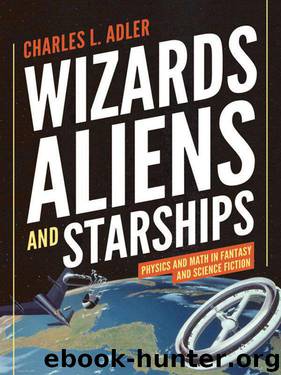Wizards, Aliens, and Starships: Physics and Math in Fantasy and Science Fiction by Adler Charles L

Author:Adler, Charles L. [Adler, Charles L.]
Language: eng
Format: epub, pdf
Publisher: Princeton University Press
Published: 2014-02-01T22:00:00+00:00
on Bert’s clock in that time. Here, r is the distance of Bert from the center of the black hole [235]. If either observer is moving relative to the center of the black hole, the formula must be changed to account for the motion. As expected, time on Bert’s clock slows to zero as one approaches the event horizon. As I mentioned in chapter 12, this gravitational time dilation and the relativistic motion effects must be taken into account for the GPS system to work. This to me, is one of the most amazing effects of relativity. Time slowing as one approaches the event horizon has been used in a number of science fiction stories, not always accurately.
Black holes have fascinated science fiction writers nearly as long as they have fascinated physicists. As Kip Thorne says, the “golden age” of black hole research was in the 1960s, and it is in literature from the 1960s and early 1970s that we find black holes first making their way into mainstream science fiction. It’s possible that the “black sun” of Arthur C. Clarke’s The City and the Stars has an early use of the idea. In that story the black sun, an artificially constructed star, is used to imprison the “Mad Mind,” a noncorporeal being created by the denizens of a galactic empire, which turned on them and nearly destroyed the galaxy [53]. If so, Clarke was being prescient, as the book predicted that eventually the Mad Mind would escape once the black sun failed. When the novel was written, in the late 1950s, it wasn’t known that black holes evaporate through Hawking radiation. Eventually (long, long after all the stars are dead) all of the black holes will boil away to nothingness.
The story “He Fell into a Dark Hole” by Jerry Pournelle features the rescue of a group of spacemen stranded in orbit around a black hole, and the ship being nearly destroyed by gravitational radiation emitted by the hole. The story is set in the same universe as The Mote in God’s Eye and is scientifically accurate except for the idea that astrophysicists would have forgotten all about black holes five centuries from now. Larry Niven, of course, wrote several stories featuring black holes, including “Singularities Make Me Nervous,” which involves an astronaut who travels backward in time by going through a black hole.
Black holes, occasionally called “collapsars,” have been used for FTL travel in a number of science fiction novels. Two that spring readily to mind are The Forever War by Joe W. Haldeman and Fiasco by Stanislaw Lem [107][151]. I’ve mentioned the first book already. The second records the attempt of a human expedition to make first contact with an alien race, the Quintans. In the book the ship uses a “gracer” (a gravitational laser, whatever that is) to make the collapsar oscillate, permitting the ship to dive through it and travel either faster than light or backward in time—the rather recondite language of the book doesn’t really make it clear which.
Download
Wizards, Aliens, and Starships: Physics and Math in Fantasy and Science Fiction by Adler Charles L.pdf
This site does not store any files on its server. We only index and link to content provided by other sites. Please contact the content providers to delete copyright contents if any and email us, we'll remove relevant links or contents immediately.
| Books & Reading | Comparative Literature |
| Criticism & Theory | Genres & Styles |
| Movements & Periods | Reference |
| Regional & Cultural | Women Authors |
4 3 2 1: A Novel by Paul Auster(12281)
The handmaid's tale by Margaret Atwood(7678)
Giovanni's Room by James Baldwin(7189)
Asking the Right Questions: A Guide to Critical Thinking by M. Neil Browne & Stuart M. Keeley(5632)
Big Magic: Creative Living Beyond Fear by Elizabeth Gilbert(5610)
Ego Is the Enemy by Ryan Holiday(5294)
The Body: A Guide for Occupants by Bill Bryson(4974)
On Writing A Memoir of the Craft by Stephen King(4863)
Ken Follett - World without end by Ken Follett(4645)
Adulting by Kelly Williams Brown(4487)
Bluets by Maggie Nelson(4472)
Eat That Frog! by Brian Tracy(4434)
Guilty Pleasures by Laurell K Hamilton(4360)
The Poetry of Pablo Neruda by Pablo Neruda(4038)
Alive: The Story of the Andes Survivors by Piers Paul Read(3968)
White Noise - A Novel by Don DeLillo(3953)
Fingerprints of the Gods by Graham Hancock(3940)
The Book of Joy by Dalai Lama(3899)
The Bookshop by Penelope Fitzgerald(3775)
